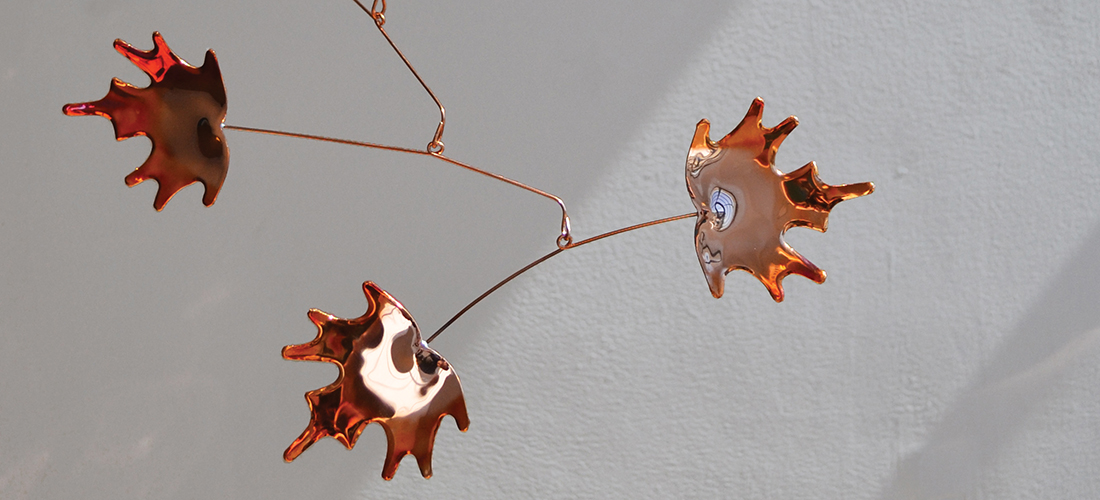
Flights of Fancy
Aerial artist Jay Jones trades in a different kind of mobile device
By Maria Johnson
Jay Jones walks into HQ Greensboro, a shared workspace on the south end of downtown, and points at the ceiling.
There, in the rafters, twirls a piece of his art: a mobile. Its long arms look like I-beams. Two white figurines, courtesy of a 3-D printer, sit at the end of a beam. Jones was inspired to make the mobile after looking at Charles Ebbets’s famous photograph, Lunch atop a Skyscraper, which captured workers taking a break over New York City in 1932.
Riding currents of air-conditioning, the mobile catches the eye, demanding a pause and a gawk.
Funny thing about mobiles, Jones observes: They’re moving, but they have the opposite effect on viewers.
“They cause people to slow down,” he says.
Here’s another funny thing about mobiles: They’ve quickened Jones’s career as an artist.
Since 2012, when he dived into mobile making full time, Jones has amassed a client list that includes several private customers and about 250 galleries, museum shops, and home furnishings stores around the world.
Abroad, his mobiles pirouette in Spain, France, Belgium and Japan.
In New York, the Museum of Modern Art and the Solomon R. Guggenheim Museum stock his mobile kits. So do the National Gallery of Art, the Smithsonian Institution and the National Building Museum in Washington, D.C.
Closer to home, the North Carolina Museum of Art in Raleigh sells his kits. You can find his assembled mobiles for sale in the Biltmore Estate gift shop and at the Grovewood Gallery, next to the Grove Park Inn in Asheville.
Area Inc., a modern home furnishings store in Greensboro, carries his pieces.
Jones also has created large, commissioned works for private homes in New York, California and Atlanta.
“It’s a challenge, being a professional artist,” says Jones, 57. “But if you have a good product, you can do it.”
A native of Arizona, Jones started making his flights of fancy in a roundabout way. After a semester of college, he landed in San Diego, where he acted and built sets for The Old Globe theater. Connections took him to New York City, where he continued making sets for Broadway shows, the New York Shakespeare Festival and the children’s TV show Pee-Wee’s Playhouse.
“That was a lot of fun,” he says.
More fun came while working with the Trisha Brown Dance Company.
Jones traveled to Naples, Italy, with renowned artist Robert Rauschenberg, who had designed the scenery for a show. A dock strike stranded the scenery at sea, so Jones and Rauschenberg made do.
“We drove around Naples, around Christmas 1986, just collecting things off the streets for sets. He’d say, ‘Build this, build that.’ He was a master of composition and structure,” says Jones.
Back home in posh Westchester County — where Jones and his growing family lived relatively low on the hog in a two-bedroom apartment inside a three-family home — he started his own furniture-building business, incorporating into his bookcases, chests and desks some of the exaggerated, cartoonish curves that he had perfected on the Playhouse children’s show.
In 1995, Jones and his family moved to North Carolina, where relatives resided and where Jones thought he might catch a break as a furniture maker.
“We had a fairly extensive client list,” he says. “We needed to find a manufacturing-friendly environment.”
He scored small victories — his hourglass bookcase was included in a Christie’s auction to benefit the Cooper-Hewitt, Smithsonian Design Museum in 1998 — but manufacturing success was difficult to sustain.
“This area is really friendly to giant manufacturers; not so much to small manufacturers,” he says. “We were purchasing materials in small amounts, but paying full price for stuff. We were not big enough for anybody to take us terribly seriously. It was too costly. We could never really get ahead on it.”
Jones took a job with the City of Greensboro in 2001. He was responsible for replacing old computer equipment with newer machines. Gradually, he became a creative go-to guy.
For libraries, he built book carts, computer tables and set pieces like a scaled-down English cottage for the children’s area at the Edwards branch and a whimsical tree for the Hemphill branch.
He managed the website for the engineering and inspections department.
He designed signs.
Once, he made the city manager a conference table from a huge pane of glass that was removed from the Melvin Municipal Office Building.
It was interesting work, but hardly the stuff of a career.
“I kept having to create my own job,” he says. “There was no path for advancement.”
In 2006, while on vacation, his family visited the National Gallery of Art in Washington, and Jones’s life was altered as he approached a large, drifting Alexander Calder mobile.
“It stopped me in my tracks,” he says. “That was the first time I saw a real mobile, not something dangling above a baby’s bed. I sat there for a long time looking at that piece.”
Jones had always thought of himself as artistic, but not necessarily an artist — more of a mechanically inclined designer.
That’s why Calder’s mobile, with all of its moving parts, spoke to him.
“I thought, ‘I get this. I know how he’s doing this,’” Jones says.
The next Christmas, his wife Naomi, an elementary school art teacher, gave him a VHS tape about Calder’s life.
“I must have watched that fifty times,” he says. “I would start-stop, start-stop, start-stop, watching the mobiles.”
He began messing around in his garage, creating his own Calderesque pieces with wood, metal and wire. A coworker asked him to make a mobile out of copper. Jones obliged with a leaf design inspired by the gingko trees that he saw while on lunch break in downtown Greensboro. A passion was kindled. Jones began carting copper mobiles to weekend craft shows. They flew out of his booth.
He diversified, offering different shapes – leaves, butterflies and birds, as well as abstract ovals, darts and squiggles. He worked in different woods. He burnished the copper with chemicals and with flame to create distinct patinas. He gave customers a choice of sizes. The best seller, then and now, was the copper ginkgo leaf.
“I sell the ginkgo leaf probably ten-to-one over everything else. It’s a pretty shape, even if you don’t know what it is. A lot of people seem to have an emotional connection to ginkgo trees. They stand for peace and longevity in Japan,” he says.
Jones’s wife, who had retail experience, guided him to wholesale market shows, where retailers bought his pieces in large numbers.
“I was eating up all of my vacation time,” he says. “It was amazing how I had a ‘little cough’ on Mondays,” he says.
In 2012, he took the plunge, quitting his city job for the high-wire life of a mobile artist.
“It’s coming along,” he says, with a grin punctuating the middle of his Rembrandt mustache and beard.
Jones works in a studio in the Old Greensborough Gateway Center on South Elm Street. His wife now runs the business side of the operation in addition to contributing design ideas and creating her own colorful paintings of animal faces.
“They all have a little attitude,” Jones says appreciatively as he scrolls through images of Naomi’s work.
For the mobile business, the Joneses employ a full-time assistant, who helps with the manufacture and assembly.
As JFJones Mobiles, they turn out 1,500–2,000 pieces a year. They subcontract some aspects of the manufacturing. Someone else in their building laser-cuts the shapes. Someone around the corner creates the 3-D figures that inhabit the I-beam mobiles.
Jones painstakingly creates new designs and commissioned pieces. He literally balances the shapes and armature until the whole thing looks right to him. This involves hours of trial and error, but it’s the only way for Jones.
“I have to do it by hand,” he says.
When he’s pleased with the result, he reverse-engineers the piece, documenting rod lengths and balance points for future reference. The price of his work ranges from $42 for a small kit to $10,000 and up for large commissioned pieces.
To date, most of his work hangs in private homes, but he’d like to change that. He’s shifting his focus toward commercial clients. Greensboro developer Andy Zimmerman, who owns HQ Greensboro, the shared workspace on Lewis Street, has been supportive.
Well-Spring, the Greensboro retirement community, bought a large piece that hangs in an atrium.
Jones dreams of creating a large, one-of-a-kind mobile for the Steven Tanger Center for the Performing Arts, scheduled to open in downtown Greensboro next year.
It would be an ideal place for him to show that art is not confined to walls or stages.
“I think there’s a big need for aerial art,” he says. “I walk into a space and think, ‘You need something up in the air here.’” OH
Maria Johnson is a contributing editor of O.Henry magazine. You can find Jay Jones’s work online at www.jfjonesmobiles.net.





